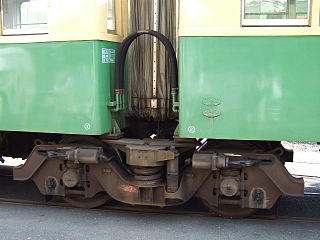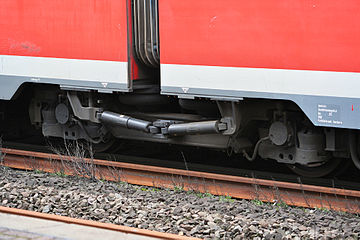Jacobs bogie

Jacobs bogies(named afterWilhelm Jakobs[1],,[2]1858–1942, a Germanmechanicalrailway engineer) are a type ofrailvehiclebogiecommonly found onarticulated railcarsandtramway vehicles.
Instead of being underneath a piece of rolling stock, Jacobs bogies are placed between two carriages. The weight of each carriage is spread across the Jacobs bogie.[1]This arrangement provides the smooth ride of bogie carriages without the additional weight and drag.
Talgotrains use modified Jacobs bogies, that only use two wheels, and the wheels are allowed to spin independently of each other, eliminatinghunting oscillation.
Background
[edit]
The first fast train using this type of bogie was the GermanFliegender Hamburgerin 1932. In the United States, such configurations were used throughout the twentieth century with some success on earlystreamlinedpassenger trainsets, such as thePioneer Zephyrin 1934, variousSouthern Pacific Daylightarticulated cars, andUnion Pacific Railroad'sM-10000.Dallas Area Rapid Transit railtrains originally used a center bogie in a two-car unit but these have been modified to add a lower center section for handicapped level entry making a 3-car unit with two Jacobs bogies.
Vehicles featuring Jacobs bogies include theAlstom-madeTGV,KTX-I,KTX-SancheonandClass 373High speed trains, theBombardier Talentseries of multiple units, theLINT41,theClass 423S-Bahnvehicles, theCanadian CN Turbo-Trains,severalFLIRTtrains,[3]IC3byAdtranz,theJR CentralL0 Seriesmaglev and theŠkoda ForCitytram.
In Australia, Jacobs bogies were first used in 1984–85 onB class Melbourne trams,which were designed to run on two former suburban railways which had been converted tolight railoperation.
Not a Jacobs bogie
[edit]
A number ofintermodal freighttrains, such as thePacer Stacktrainrun by US logistics companyXPO Logistics,usecontainerwell carsjoined in groups of three to five, with fourside bearingson top of thebolsterof a standard North Americanbogiebetween the individual cars.
Locomotives
[edit]Some triple-bogied two-section electric locomotives such as theNZR EW classhave an articulated body supported on the centre bogie. Other types ofBo-Bo-Bolocomotives instead use a body shell that has enough allowance for sideplay in the central bogie.
Tram (streetcar)
[edit]The Jacobs bogie can be found in trams (streetcars) such as theTatra K2and Oslo'sSL79.The first 100% low floor tram with pivoting bogies, theŠkoda ForCity,also uses modified Jacobs bogies.

US interurban trains
[edit]
On this crossover between the tram (streetcar) and thehigh-speed train,Jacobs bogies occurred on the latest equipment of any significance, the twoElectrolinertrains (1941–1976). They were suited forstreetswithtight curves,theChicago Eland running through the countryside at approximately 140 km/h (87 mph). They served theChicago–Milwaukee lineand later thePhiladelphia area.
Advantages
[edit]- Safety, because the trains are less prone to collapse like an accordion after derailing. AEurostar train has been recordedas having derailed at a speed close to 300 km/h with no resultant loss of life or severe injuries among its passengers.[4]
- Lower weight and simpler and cheaper construction because bogies are heavy, expensive, and complex structures.
- Lessrail squealand other wheel-to-railnoisebecause of fewer bogies.
Disadvantages
[edit]- The cars of the vehicle/unit are semi-permanently coupled and can only be separated in the workshop. However, some flexibility may be achieved by coupling two or three units together into one train.
- Fewer bogies and fewerwheelsetsmean greater axle loads – if everything else is equal.
- Larger pivot distances for equivalent section length. Each section has to be shorter to provide adequate clearance for the vehicle on the inside of curves. More sections are required for equal capacity compared to a conventional unit.
Gallery
[edit]- Examples of Jacobs bogies
-
Jacobs bogie on aTER regional traininAlsace,France
-
Jakobs bogie on theČD Class 844/Pesa SA
-
Disassembled joint of aStadler FLIRTwith the bogie removed
-
Jacobs bogie on anEnoshima Electric Railwaytrain.
-
Jacobs bogie on aDBAG Class 425train.
-
Schema of a Jacobs bogie, shown on the upper half
-
A closeup of a jacobs bogie on the preservedNebraska Zephyr
-
Jakobs bogie on theDoppelstock-Stromlinien-Wendezugof theLübeck-Büchen Railway Companyin 1936
References
[edit]- ^ab"Bogie designs"(PDF).SKF.2012.
- ^"Bogies".The Railway Technical Website.
- ^Leutenegger Engineering & Consulting Forged Aluminium Parts for Rolling Stock Structures
- ^"Eurostar train derails in France".BBC News. 2000-06-05.Retrieved2014-03-26.








